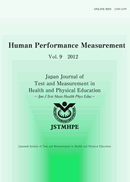In this study we obtained the following findings by analyzing the relationship between ADL and the results of the new physical fitness test advocated by the Ministry of Education, Culture, Sports, Science and Technology in a total of 376 healthy older adult subjects (223 males and 153 females), from the viewpoint of age-related change of physical fitness and ADL.
1. In respect to physical fitness, sex-related difference was noticed in muscular strength and endurance. However, no sex-related difference was detected in flexibility or sense of balance. Regarding age-related difference, there was not a major difference between the age brackets of the early 60s and late 60s in either sex, but the difference in physical fitness was noticed to be remarkably large in the 70s.
2. In respect to ADL, sex-related difference was noticed in the questions that required muscular strength, and the male subjects got high scores in those questions. Regarding age-related difference, ADL was demonstrated to be low in the 70s in both sexes.
3. In respect to ADL score, both the male and the female subjects got a high score of “three points” in questions about the activities of everyday life, while they got a low score of “one point” in questions that required muscular strength.
4. In respect to the relationship between physical fitness and ADL, high partial correlation was noticed in question 6 “standing on one leg with eyes open” and question 12 “sitting up from supine position” in both sexes. In addition, it was suggested that women’s ADL could be estimated by the 10-meter hurdle-walking test.
View full abstract
